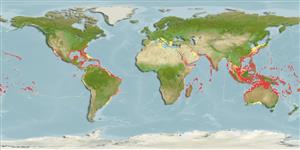Polychaeta |
Sabellida |
Serpulidae
Environment: milieu / climate zone / depth range / distribution range
Ecology
Reef-associated. Tropical
Circumtropical.
Length at first maturity / Size / Weight / Age
Maturity: Lm ? range ? - ? cm Max length : 20.0 cm DL male/unsexed; (Ref. 81049)
Calcareous tube can reach up to 20 cm in length and is usually deeply embedded in the coral skeleton. Planktonic larval phase lasts for 9 to 12 days and the average life span is over 30 years. A dioecious filter feeder that is often mistaken to be a boring species. Larvae actually settles on exposed corals skeleton and extend their tubes toward the living tissue, which subsequently obscures the tube. Simultaneous spawning of male and female species and its host corals (Orbicella annularis, O. faveolata, O. franksi, Montastraea cavernosa, Pseudodiploria strigosa), occurred in the evening during slack neap tides with nominal wind and wave action. Such conditions minimize gamete distribution by water turbulence and wave action, increasing the chances of fertilization (Ref. 81049). Part of fouling communities attached to raft frames in mariculture zones (Ref. 127121).
Life cycle and mating behavior
Maturity | Reproduction | Spawning | Eggs | Fecundity | Larvae
Planktotrophic larval phase lasts for 9-12 days. Within the first 24 hrs the first larval ocelli (compound eyes) develop facilitating positive phototaxis to visible light of wavelengths shorter than 590nm.
Bisby, F.A., M.A. Ruggiero, K.L. Wilson, M. Cachuela-Palacio, S.W. Kimani, Y.R. Roskov, A. Soulier-Perkins and J. van Hertum 2005 Species 2000 & ITIS Catalogue of Life: 2005 Annual Checklist. CD-ROM; Species 2000: Reading, U.K. (Ref. 19)
IUCN Red List Status
(Ref. 130435: Version 2025-1)
CITES status (Ref. 108899)
Not Evaluated
Not Evaluated
Threat to humans
Human uses
| FishSource |
Tools
More information
Trophic EcologyFood items (preys)
Diet composition
Food consumption
Predators
Population dynamicsGrowth
Max. ages / sizes
Length-weight rel.
Length-length rel.
Length-frequencies
Mass conversion
Abundance
PhysiologyOxygen consumption
Human RelatedStamps, coins, misc.
Internet sources
Estimates based on models
Preferred temperature
(Ref.
115969): 23.5 - 28.8, mean 27.2 (based on 1428 cells).
Fishing Vulnerability
Low vulnerability (10 of 100).
Price category
Unknown.
